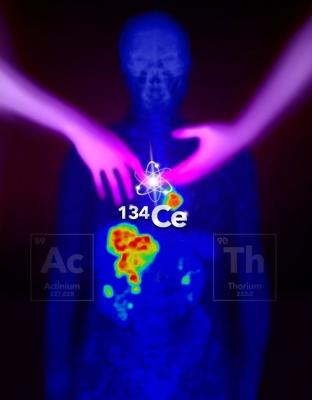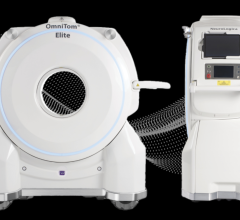
Cerium-134 can be targeted to provide an imaging analogue for two different therapy isotopes, actinium-225 and thorium-227. This helps scientists understand these therapy isotopes and develop new treatments. Image courtesy of Donald Montoya, Los Alamos National Laboratory
August 6, 2021 — A multidisciplinary team has demonstrated the production, purification, and potential application of cerium-134. This isotope decays into lanthanum-134, an isotope useful for positron emission tomography (PET) imaging. PET imaging uses radioactive substances to visualize and measure processes in the body. It is an essential tool in diagnosing disease and monitoring treatment. The team demonstrated the use of cerium-134 for PET imaging in mice. The results show that cerium-134, through its lanthanum-134 decay product, could serve as a diagnostic partner for medical treatments based on actinium-225 or thorium-227.
Increasing the availability of cerium-134 for imaging could benefit the medical use of therapeutic radioactive isotopes. These isotopes emit alpha particles that target cancer and other diseases. Cerium-134 is chemically similar to actinium-225 and thorium-227. This means cerium-134 can be attached to the same targeting systems as the therapeutic isotopes. Using the same targeting systems means that cerium-134 diagnostics and actinium-225 and thorium-227 treatments will behave in similar ways in the body. This allows scientists to use cerium-134 to view and monitor actinium-225 and thorium-227 as they work. The result is more information for medical researchers and clinicians treating disease.
Developing targeted medical interventions that use radioactive isotopes to treat disease could transform how science treats disease. This approach involves selectively delivering an alpha-emitting radioisotope like actinium-225 and thorium-227 to diseased cells such as tumors. The radioactive decay kills the diseased cell while sparing the surrounding healthy tissue. Widespread implementation of this approach would be easier if medical practitioners had more tools to non-invasively and accurately track the radioactive medication in the body. One such tool is PET imaging with cerium-134. Unfortunately, actinium-225, thorium-227, and many other alpha-emitting radioisotopes are incompatible with PET imaging. The team demonstrated in mice that PET imaging cerium-134, through its lanthanum-134 decay product, can track actinium-225 and thorium-227. Greater availability of cerium-134 therefore opens the door to the development of additional targeted cancer therapies.
For more information: www.isotopes.gov


 July 30, 2024
July 30, 2024 








